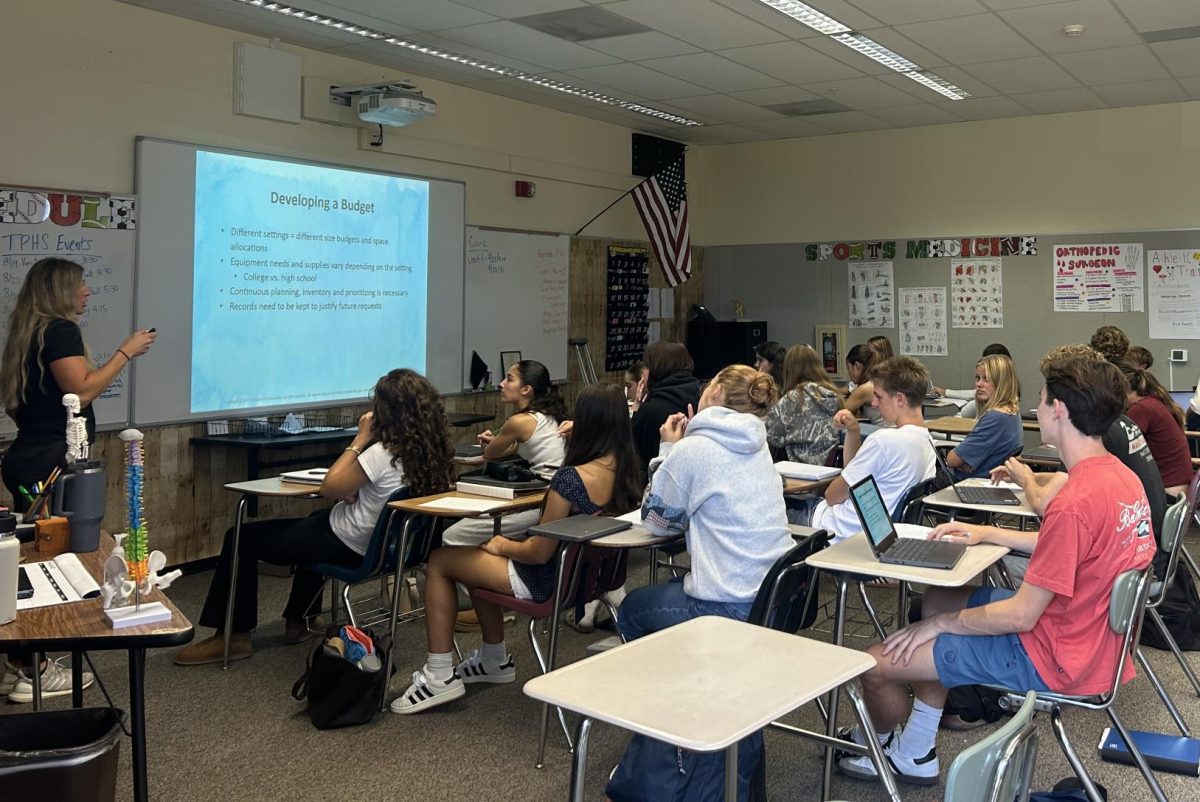
Riley Gunn
Lacey Sovacool lectures her fourth period Sports Medicine class, describing the process of developing budgets based on different settings and needs for equipment. Sports Medicine, which became a Career Technical Education pathway this year, was previously an external program at the school.
As students dive into the school year, an exciting new academic program emerges: Sports Medicine. In previous years, TPHS Sports Medicine was an extracurricular. However, the addition of an elective pathway taught by Lacey Sovacool provides students with an introduction into the realm of athletic healthcare, and a starting point for those aspiring to pursue careers in medical or sports fields.
Sovacool outlined the topics covered in the course.
“There’s a focus on injury prevention, injury rehabilitation, injury assessment and evaluation,” Sovacool said. “[Following it], Cardiopulmonary Resuscitation (CPR) and Automated External Defibrillator (AED).”
By the conclusion of the first semester, students will undergo comprehensive training in CPR and AED, leading to their certification in both. They will also learn various aid techniques, earning Basic Life Support and First Aid certifications through the American Heart Association. The second semester delves into a more detailed study on the human body with a core focus on the structure and function of different joints.
“We will be learning how to palpate and identify different structures [including] bones, ligaments, tendons, different muscles and then common injuries that happen to each joint,” Sovacool said. “Then we’ll move our way up to the upper extremity, and then look at the head, spine, abdomen and chest.”
Sports medicine is rapidly growing in popularity as schools place a stronger emphasis on health and wellness, particularly in athletics.
“We have such a need for this class because there are so many students that share an interest in a branch of Sports Medicine, or they’re interested in medicine, but they aren’t sure what type, Sovacool said. “So, they take this class and they get to learn a little bit more about the different fields of sports medicine.”
Sports Medicine 1 is just the first class of the Sports Medicine Career Technical Education pathway. Next year, students can decide to take Sports Medicine 2.
Sovacool prepares her classroom for success by starting with teamwork and foundational skills.
“Right now, we’re just kind of laying the foundation, really looking at … the members of the Sports Med team, and who makes up all the different pieces of the team, and how they collaborate with one another and how they communicate to best support their patients or their athletes,” Sovacool said.
The course also provides experience directly related to careers in the field. Students receive a glimpse into the roles and responsibilities of an athletic trainer, physical therapist, physician, orthopedic surgeon, sports psychologist, nutritionist and strength and conditioning specialist.
“If college isn’t the path for you or while you’re going to college, and you want a part time career, personal training is a great job,” Sovacool said. “If students are passionate about sports and helping patients or athletes train without having to go to college, they’ll become a certified personal trainer.”
Sports Medicine students Declan Egner (10) and Isla Shew (10) hope to pursue careers related to medicine in the future.
“I want to either go into orthopedics or I would want to be a CRNA,” Shew said.
Inspired by their experiences, both students have clear goals for their future.
“In the future I plan to be associated with some sort of Sports Medicine related career,” Egner said.
Both Egner and Shew were motivated to take this course due to prior physical injuries.
“I used to get a lot of ankle problems and that kind of inspired me in a way,” Shew said. “By taking this course I’m hoping to gain things that will support me as I get older. I am planning on going into the medical field. And I feel like starting this kind of pathway in high school will help me to understand if I’m truly interested in this being my career.”
Egner, who previously experienced a back injury, is still undergoing physical therapy.
“I hope to further my knowledge, and [know] how to help my teammate if they get hurt, and also [make] new friends”, Egner said.
Sovacool described the community she hopes to build through this pathway.
“I want them to enjoy sports events, but also view them from a Sports Medicine perspective,” Sovacool said. “I want them to consider what the Sports Med team does when an athlete is injured, including their treatment and techniques.”
Students in this class can now look at injuries on the field from an inside point of view.
“I hope they shift their perspective from being just a fan to also seeing things through the eyes of a Sports Medicine professional,” Sovacool said. “So what is a Sports Med Team doing when an athlete gets injured? How are they treating that? How are they responding? What techniques are they using?”
Sovacool plans to continue to grow the program.
“I’m so passionate about the field of Sports Medicine and athletic training,” Sovacool said. “My goal is to just share that with students like my passion for the field, but then also to just educate them on everything that Sports Medicine has to offer, and hopefully inspire them right to then go and pursue, possibly a career in Sports Medicine. We always need professionals.”